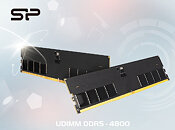Friday, March 4th 2022
Silicon Power Announces Next-Gen DDR5 UDIMMs
Silicon Power (SP) releases its newest UDIMM memory module with the latest, groundbreaking DDR5 technology. Read on to learn why it's time to ditch your DDR4 module and make the upgrade. Taking speed, capacity, and reliability even further, the cutting-edge technology of this DDR5 module gives that next-level edge for your system's performance. With aggressive speeds of 4800 MHz, it's 1.5x faster than standard 3200 MHz DDR4 to provide multi-core CPUs with extreme responsiveness and the power to multi-task seamlessly.
Even with all of its extra power, this DDR5 module improves upon its predecessor with on-module voltage regulation. A power management integrated circuit (PMIC) reduces the burden on the motherboard control and results in a lower voltage of 1.1 V versus 1.2 V for DDR4 for even less power consumption.Even More Reasons To Upgrade
Even with all of its extra power, this DDR5 module improves upon its predecessor with on-module voltage regulation. A power management integrated circuit (PMIC) reduces the burden on the motherboard control and results in a lower voltage of 1.1 V versus 1.2 V for DDR4 for even less power consumption.Even More Reasons To Upgrade
- Doubled chip unit capacity compared to DDR4 (from 16 GB to 32 GB) for seamless multi-tasking
- Improved reliability versus DDR4 with On-Die Error Correction Code (ECC)
- Optimized efficiency with two independent 32-bit channels per module
- High computing performance with double the banks and double the burst length compared to DDR4

10 Comments on Silicon Power Announces Next-Gen DDR5 UDIMMs
P.S. Those heat spreaders look amazing.
2. Let me guess, CL40?
:roll::roll::roll:
You'd never be able to run ddr4 at 3200 with only 1.2v :laugh: 1.35v minimum and under stress it will use more than that.
I've not seen any ddr5 dimm volage readings with hwinfo min/ max but manufactures saying 1.1v I'm pretty sure that is a minimum xmp voltage not a xmp max voltage.
I believe that by summer 6000-6400 will be much more common
The platform to feed and support those speeds uhh... they require a bit more time in the oven.
Memory performance is not measured purely in bandwidth, latency is the other critical metric.
Think of bandwidth as the speed of a vehicle on a straight path, and latency the speed at which it turns. Some applications benefit more from bandwidth, others from less latency. You'll notice Alder Lake RAM comparisons show nearly similar performance in gaming, but the 1% lows could be worse with DDR5.
There won't be MUCH practical value to DDR5 until those latencies come way down. The bandwidth has less than doubled, but the time waiting between various memory operations has more than doubled. Given the choice I'd rather have DDR4-3200 CL14 than DDR5-6000 CL36. No appreciable difference for the massive $$$ expenditure.
I think the DDR5 offerings we are looking at right now are more akin to when DDR4 2400 and 2666 we're the available upgrades when leaving your DDR3-1866 platform.
That's some fancy figuring there
ddr5 is seen as quad channel even though only two sticks are used
On your example of 6000 at cl36 if you cut both in half 3000 at cl18 it's true that is crap in ddr4 land numbers lol :laugh:
Latency will probably be the more desirable metric now, like how we have reached 7000MB/s on consumer SSDs, but random IOPS is more desirable for real world usage and system responsiveness (Optane vs NAND). Or how having more cache on the chip to reduce latency of having to accessing RAM (AMD willing to even drop some MHZ to stack more cache and achieve significant overall performance gain).
However, I'm sure DDR5 will have a huge performance uplift on APUs/iGPUs even with the initial DDR5 specs.